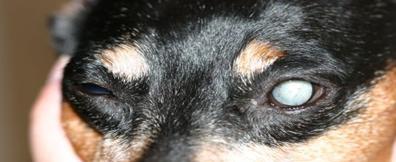When it comes to cataracts, many people's first reaction is that people will get this disease, but they don't know that pets can also get this disease. What's even more surprising is that cataracts are not exclusive to elderly pets. They grow up with pets.
sick dog
1. Cataracts
Cataract is an eye disease in which the lens capsule or lens is clouded and vision impairment occurs.
Cataract in left eye of dog

sick dog
II. Etiology
1 Congenital causes
Congenital cataract is caused by congenital hypoplasia of the lens and its capsule, which is related to genetic and non-genetic.
2 Acquired causes
Acquired cataracts are often secondary to uveitis, retinitis, glaucoma, corneal perforation, rupture of the anterior lens capsule, long-term X-ray exposure, long-term use of corticosteroids, and secondary to diabetes.
3. Symptoms
Congenital cataracts occur at or shortly after birth, and are mostly bilateral.
Sick dog eye chart
Lens and capsule opacity, pupil discoloration
eye chart
Obvious turbidity, white eyes
4. Pathological process
There are many reasons for cataract, but no matter what the cause is, the permeability of the crystal will increase during the onset process, resulting in the loss of the barrier effect of the crystal, resulting in the turbidity of the crystal.
1 Primary cataract
The focal opacity of the lens and capsule has no effect on the correlative reflex and visual acuity.
2 Infantile cataracts
The turbid area of the lens is diffused, but some cortex is transparent, and the cortex of the lens expands and reflects light, which has a certain impact on vision.
In juvenile cataract, the area of lens opacity is larger.
3 Mature cataracts
Cataract infancy chart
The lens was all opaque, and the lens cortex was swollen.
Cataract maturity chart
Mature cataract, red eye and corneal edema.
4. Cataract in overmature period
The lens shrinks, the capsule shrinks, the cortex liquefies and decomposes, the lens nucleus sinks, the light reflection is blurred, and there is no vision.
Transition mature cataract
In over-mature cataract, most of the lens is absorbed, the cortex is completely liquefied, the dense lens sinks in the capsule due to gravity, the lens volume shrinks, the capsule decreases due to tension, and the capsular bag shrinks.
V. Diagnosis
According to the medical history and clinical symptoms, such as whether there is milky white in the deep part of the pupil, whether the light is reflected, whether the fundus can be observed by the ophthalmoscope, etc.
Six, treatment
1 Medication
There is no ideal drug to treat cataracts.
2 Surgical therapy
Once the lens cannot be absorbed, in the absence of uveitis and the retina is normal, surgery should be performed as soon as possible to improve vision.
The application of cataract surgery is analyzed according to the specific situation. This article is only used for the understanding of cataract disease. Please correct any deviations in understanding. Please follow the doctor's advice for specific situations.
